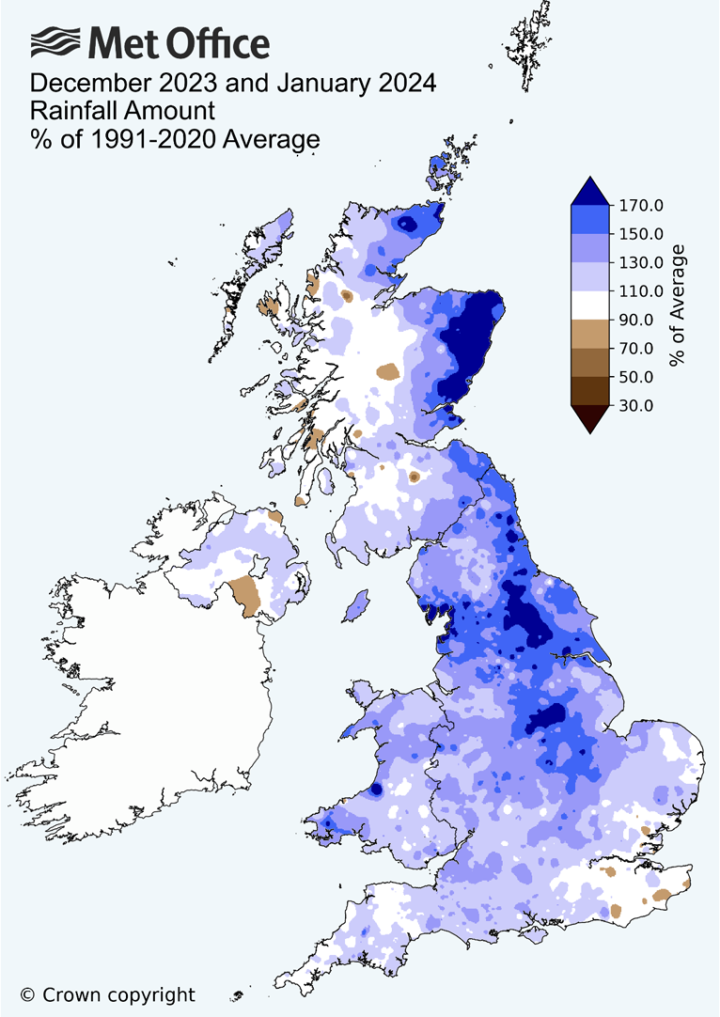Winter flood warnings and alerts on grade 1 and 2 farmland in England
The number of flood warnings on England’s best farmland this winter hit a record high of over 1000, exceeding the previous record by a fifth.
Last updated:
Executive summary
The winter of 2023/24 saw the highest number of flood warnings and alerts on England’s best farmland since the current system began in 2006. In total, there were 1008 flood warnings on Grade 1 and 2 farmland and 3344 flood alerts. This compares to previous records in the winter of 2019/20 of 775 warnings and 2808 alerts.
Although only a minority of English farmland, grade 1 and 2 land is the best and most productive land available for food production. It is typically low lying, and prone to flood risk. This analysis shows an increasing level of flood risk over time, suggesting that extreme weather linked to climate change presents an escalating and increasingly systemic risk to our food security, given the outsized impact of flooding on our most productive land.
In the winter of 2019/20, over 11% of grade 1 land was subject to at least one flood warning. Flood alerts were issued across 422,120ha of flood alert areas. Due to overlapping alert areas, this exceeded the 354,562ha of grade 1 farmland, making it impossible within the constraints of this analysis to determine the true area of grade 1 farmland subject to at least one flood alert. However, the fact that flood alerts amounted to 119% of grade 1 farmland including double counting does indicate the scale of flood risk this winter.
What are the UK's land grades?
What do the agricultural grading mean for crops?
The British government uses the Agricultural Land Classification system to designate land quality types.
Grade 1: excellent quality agricultural land - little to no limitations to agricultural use. This land can support a very wide range of agricultural and horticultural crops including top fruit, soft fruit salad crops and winter harvested vegetables. Yields are consistently high.
Grade 2: very good quality agricultural land - minor limitations which affect crop yield, cultivations or harvesting. It can support a wide range of agricultural and horticultural crops but there can be some reduced flexibility on land within the grade, which causes difficulty in the production of more demanding crops e.g. winter harvested vegetables and arable root crops. This land is high yielding but may be lower or more variable than Grade 1.
Grade 3: good to moderate quality land - moderate limitations that affect the choice of crops to be grown, timing and type of cultivation, harvesting or yield. The yield of more demanding crops grown on this land is generally lower or more variable than on Grade 1 and 2.
Grade 4: poor quality agricultural land - suffers severe limitations that significantly restrict the range and/or yield of crops to be grown. This land is mainly suited to grass with occasion arable crops – the yields of which are variable. In moist climates grass yields are likely to be moderate to high but there are often difficulties in utilisation. Very droughty arable land is also included in this land grade.
Grade 5: very poor quality agricultural land - This land has severe limitations which restricts use to permanent pasture or rough grazing, except for occasional pioneer forage crops.
What's the connection between Grade 1 and 2 land and flood risk?
Grade 1 farmland though is typically low lying, and therefore prone to flood risk. Grade 2 farmland is also, although to a lesser extent.
The Environment Agency assess flood risk using parallel flood warning and alert areas.
The difference between a flood warning and flood alert is shown below.

How is flooding affecting UK grade 1 and 2 farmland floods?
The winter of 2023/24 was one of the wettest on record, and storm rainfall was made 20% heavier by climate change, according to World weather Attribution.

What does additional flooding mean for Grade 1 and 2 farmland?
Last winter, 1008 flood warnings were issued on grade 1 and 2 farmland, our most productive land, up from a previous high of 775 in the winter of 2019/20. Flood warnings indicate that flooding is ‘expected’ in an area. As well as a record high number of warnings, 3344 flood alerts were also issued on grade 1 and 2 land, which indicate that flooding is ‘possible’. This again is an all time high, smashing the previous winter record of 2808 set in 2019/20.
When considering just grade 1 farmland, the best land used for high value crops such as vegetables, bread wheat and potatoes, over 11% was hit by at least one flood warning last winter. On top of this, many farmers struggled with waterlogged fields and failed to get crops established.
The combination of unprecedented flood risk and the sheer volume of rain saturating soils may have reduced this year’s harvest by up to a fifth, knocking nearly a billion pounds off arable farm revenues.
A study by World Weather Attribution (WWA) published in May this year estimated that the UK’s wet winter was made four times more likely due to climate change, with rain on stormy days 20% heavier.
